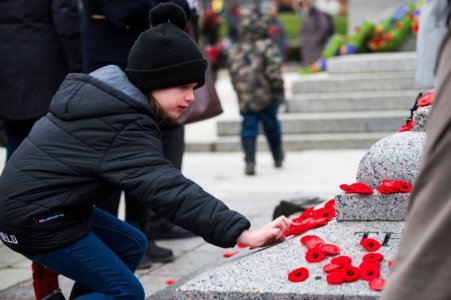My Father ( yes you read that correctly ) served in the Canadian Army in The Great War, as a member of the Canadian Machine Gun Corps, from October the 15th of 1915, to his eventual return to Toronto on the 19th of July in 1919. He added a year to his age in order to appear to be 18. He was at all of the major battles that the Canadians were involved in, including the stunning victory at Vimy ridge on April the 8th of 1917. The French and then the British had attacked the ridge in the past, and both armies had failed to take this commanding ridge in northern France.
For the first time in the war, the entire 4 Infantry Divisions of the Canadian Army would attack as one huge force of 80,000 men. Previously the Canadians had fought under British command. This time, everything would be planned and executed by the Canadians themselves. The planning started 5 months before hand, with nightly trench raids by the Canadians, who were taking German prisoners for intelligence information, and to map out the enemy trench systems. Far to the rear of the front lines, practice areas were laid out to allow individual infantry companies to rehearse their attacks over and over again, following the advance timing of moving a hundred yards every 3 minutes, tight behind the creeping barrage of the artillery guns.
In a radical departure from British Army doctrine at that time, the Canadian Army printed and distributed 40 thousand maps of the attack formation's landscape. Every Corporal in charge of a ten man section had his own map, showing his start line, all the intermediate targets along the way, and his eventual location at the top of the Ridge. In the months before the attack, the Canadian artillery spotters built a giant map showing all of the German artillery gun positions, using new technology, including sound recording equipment, and gun flash triangulation mathematics.
Tunnels were dug under the German trenches at depths of 100 feet, by special companies of Canadian miners, which were either filled with explosives to be blown on the morning of the attack, or to be used to get a thousand men 400 yards closer to the ridge when they came up out of the tunnels.
On April the 8th of 1917, at 530 am, 983 artillery guns opened fire on Vimy Ridge, and 150 Vickers machine guns also opened fire. In the first 90 minutes of the attack, the guns took out 85 percent of the German artillery guns, and the machine guns fired a mazing SEVEN MILLION ROUNDS of 303 ammunition at the German trench system. This kept the Germans deep in their dugouts, while the first wave of the Canadian infantry were moving forward, behind their creeping barrage of protective shell fire. The new number 106 artillery fuse was doing it's job of cutting through the barbed wire barriers .
Each of the Canadian Battalions had special groups made up of light machine gunners, hand grenade men, rifle grenadiers, and men with 10 pound explosive charges to blow the German strong points. The basic tactic was "reinforce success, not failure.
By noon, the Ridge was in Canadian hands. They had been victorious, at the place where both the French and the British had failed, and they did it with one hundred thousand men FEWER than the British had used. A triumph, the first clear cut victory by an Allied force, since the start of the war in 1914. This victory at Vimy Ridge, elevated Canada from being a British Colony, to being a true nation. Vimy Ridge is where Canada became " The True North Strong And Free ". As a result, Canada was asked to be a signator to the Treaty of Versailles in Paris in 1919. This was a recognition of our emerging status in the world.
Oh, yes, my Father survived the war, although he was wounded 3 times, and lost his hearing in his right ear. Firing a few million rounds of machine gun ammunition will do that to your ears, right? I was born in 1946 from his second marriage. Dad lived to age 83, dying in Toronto in 1981. He was all ways proud to say that "He was a Vimy Man". John Carl Bunting 201018 4th Battalion Canadian Machine Gun Corps. JIMB.


